
(L to R) Likud Party leader Benjamin Netanyahu and U.S. President Barack Obama.
Barack Obama's economic team likes to say that crisis breeds opportunity. His foreign policy team is unlikely to feel that way about the political turmoil in Israel and the Palestinian territories right now. The ascension of Benjamin Netanyahu in the wake of the fragmented Israeli parliamentary elections puts a hawk in control in Jerusalem and sets up a period of political uncertainty that blunts any early moves the U.S. had planned to make in pursuit of peace. But the Obama administration has pledged an early diplomatic push and seems intent on sticking to it, which leaves Hillary Clinton and her Middle East envoy George Mitchell undertaking a kind of zombie peace process that moves around but has no life. (See pictures of people around the world watching Obama's Inauguration.)
The first step will be support for the effort to rebuild Gaza. John Kerry's congressional delegation to Gaza this week was the first move in that direction, signaling support from the U.S. for reconstructing the devastated enclave. Secretary of State Clinton has confirmed that she will attend the international donors' conference in Cairo March 2. How much the U.S. will actually put up for reconstruction of the Hamas-dominated strip may be less important than the general symbolic support for the people of Gaza, a break from the Bush administration's general policy of ignoring them.
Next week, Clinton's Middle East envoy, George Mitchell, is expected to travel to the region. With a government still unformed by soon-to-be Prime Minister Netanyahu, Mitchell is not going to have a lot of business to transact in Jerusalem. But he is already signaling a shift in the U.S. approach to the divided Palestinian leadership. In a 45-minute telephone conversation with U.S. Jewish leaders Thursday, Mitchell reportedly expressed support for a unity government involving both the impotent Palestinian Authority and Hamas. Though the U.S. will adhere to the four conditions for talking to Hamas that Clinton laid out in her confirmation hearing, the move allows European and Arab diplomats to try and bridge the divide between the Palestinian factions.
Will any of this produce real movement toward peace? They will, at minimum, create a sense among the players in the Middle East that the Obama administration is breaking with the Bush approach to Arab-Israeli peace. Neither move would have been possible under even the more flexible approach taken by Condoleezza Rice in the last year of the Bush administration, when it made a belated attempt to pursue peace. (See pictures of George W. Bush in the Middle East.)
But the formation of a government under Netanyahu is going to unfold slowly and uncertainly and will be determined largely by local political concerns impervious to outside influence. Most likely, they will produce a weak government unwilling and unable to pursue any political objectives with an equally unstable Palestinian government, unified or not.
The biggest danger now is that Washington expends too much diplomatic activity at a time when it is least likely to have an effect. The U.S., as it continues to engage, faces the danger of becoming part of the furniture if George Mitchell begins making monthly visits during a period of minimal possibility for progress. "One or two listening tours will do," says Rob Malley of the International Crisis Group, "But at a certain point it will become better not to go than to go." Indeed, it may be better to hope a resting Middle East peace process can be resurrected in the future than to insist on creating the appearance of life when there is none.
